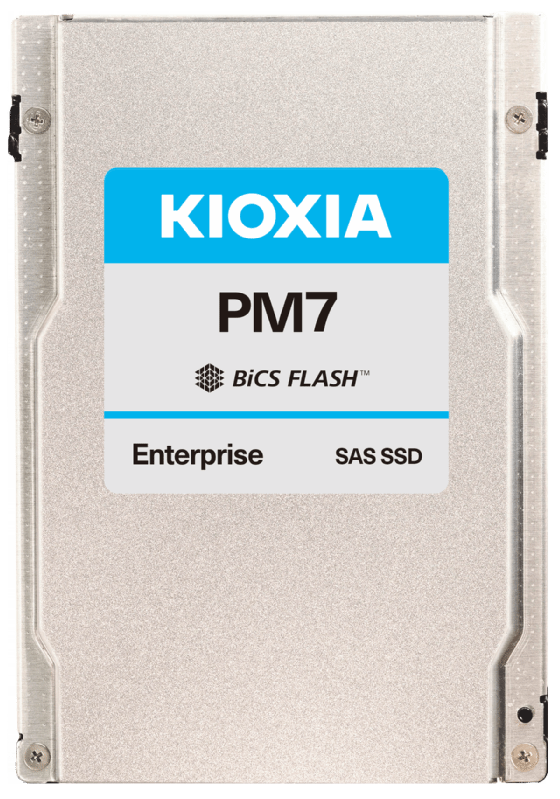
Getty Images/iStockphoto
Kioxia ups NAND ante with new 24G SAS SSD
Kioxia unveils its second-generation 24G SAS SSDs, the PM7, building off its previous generation to provide added performance and support for the new FIPS standard.
Kioxia released its second-generation 24G SAS SSDs with a focus on performance and security.
The PM7 series follows Kioxia's PM6, a line of 24G or SAS-4 SSDs. It includes a new generation of NAND and better storage performance for use cases such as high-performance computing (HPC), AI, caching and financial trading. The PM7 also adds support for the current version of the federal information processing standards (FIPS), the new standard adding requirements for cryptographic modules.
SAS is one of the primary interfaces used in the enterprise. While faster interfaces such as PCIe Gen 4 and Gen 5 exist, SAS maintains a strong presence given its lower price points and relative performance, according to Don Jeanette, vice president at Trendfocus.
"[SAS] is a legacy protocol that has been around for a while now," he said. "It is a mature market where there is a lot of demand still."
And Kioxia is one of its dominant players, making up over 30% of the SAS market, with Samsung leading the market at over half, according to Jeanette.
PM7 and 24G SAS
SAS, the serial-attached SCSI interface, is one of the main enterprise interfaces used in SSDs and HDDs to connect storage to the host, according to the SCSI Trade Association (STA). For 18 years, the SAS interface has evolved; each time, it has doubled in effective bandwidth until reaching 24G's 22.5 Gbit/s today.
Kioxia was the first to market with a 24G or SAS-4 SSD with the PM6 in June 2020, and now it's launching the PM7 to better take advantage of the new standard.
The 24G interface brings consistent performance across large and mixed-protocol topologies. It also improves SSD efficiency, and provides lower latency as well as a higher quality of service, according to Cameron Brett, senior director of enterprise and cloud storage at Kioxia America Inc., a marketing arm for the vendor, and president of STA.
The PM7 uses the same system-on-a-chip (SoC) and controller as the PM6, according to Steve Garceau, SSD product manager at Kioxia. The PM7 utilizes Kioxia's fifth-generation, 112-layer BiCS 3D flash memory, a TLC NAND-based flash and an upgrade over the PM6's 96-layer NAND. While the flash has been upgraded, customers can use their previous qualifications for the drive in largely the same way.
"[Customers] can leverage a lot of things that they did [with the PM6], such as host interaction to the drive being the same," he said. "The front-end firmware is exactly the same, just a few tweaks for the new NAND."
The PM7 delivers a bandwidth of 4.2 GBps and up to 720,000 IOPS in random read. It includes several features that were present in the PM6, such as power-loss protection as well as data protection features like error correction codes (ECC) and die failure recovery, double-parity protection to prevent errors in data transmission.
"No path in the SoC is unprotected. It uses either ECC or parity, and it has flash drive failure protection built in," Garceau said. "An entire die could fail and [users can] recover due to RAID [redundant array of independent disks] algorithms."
Like the PM6, the PM7 also includes additional security features such as sanitize instant erase, a deletion of the mapping table and all blocks written to the table; self-encrypting drives; and support for the FIPS, a set of requirements for data encryption.
The PM7 takes security a step further than the PM6 by pursuing qualification for FIPS-140-3, the latest version of the federal standard, making the PM7 the only SAS SSD certified for the new standard, Garceau said.
Also, like the PM6, PM7 SSDs are offered in a 2.5-inch, 15mm form factor; come in two endurance models, one drive write per day and three DWPD, and are available in capacities ranging from 1.8 TB to 30.72 TB, the largest-capacity SAS SSD available, according to Garceau.
Garceau said there is demand for high-capacity SSDs here and there in the enterprise, but the demand is spotty and conservative, as losing that much data at once can be time consuming to recover.
"You start failing 30 terabyte drives in a RAID array, that's a really long rebuild time," he said.

Adoption, interoperability and the future
Customer adoption of the 24G SAS protocol is better than Garceau originally expected, mainly in servers and hybrid storage products.
The 24G SAS protocol may create less buzz than PCIe Gen 4 or Gen 5, but it comes with an ecosystem to take advantage of the standard, according to STA. This includes host bus adapters, RAID adapters, cables, connectors, SSDs, HDDs, storage arrays and servers with more coming in the future, according to the STA.
The continued interest in SAS is also due to the interface's effectiveness and reliability, Garceau said.
"We wouldn't make a product with a next-gen SAS interface if there wasn't a market for it," he said.






